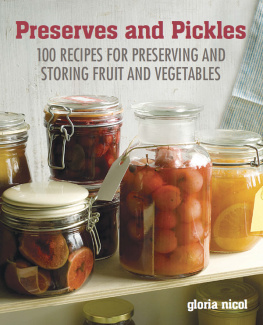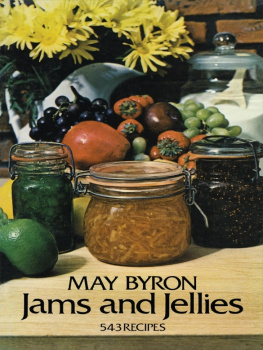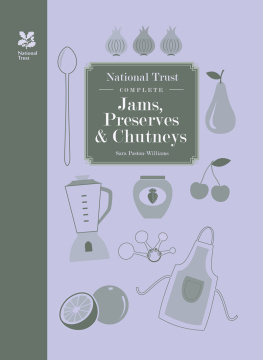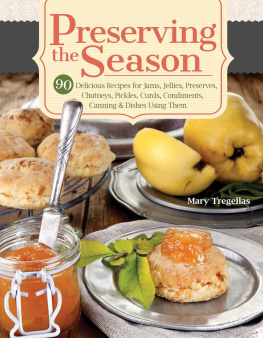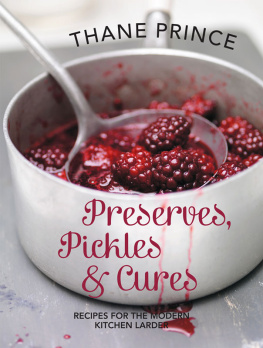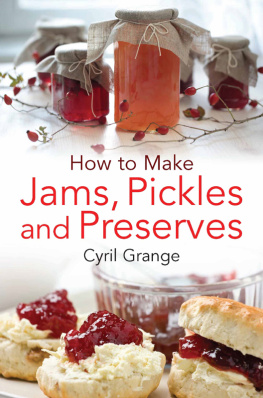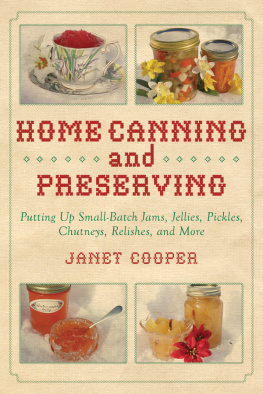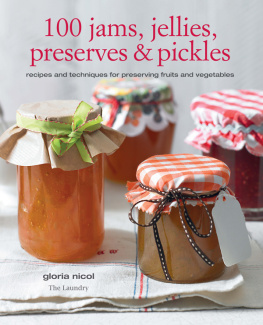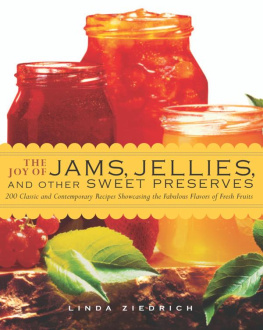Preserves and Pickles


Preserves and Pickles
100 RECIPES FOR PRESERVING AND STORING FRUIT AND VEGETABLES

gloria nicol

Project Editor: | Gillian Haslam |
Text Editors: | Alison Bolus and Eleanor Van Zandt |
Designer: | Barbara Zuiga |
Photographer: | Gloria Nicol |
Stylist: | Sue Rowlands |
: photographer Winfried Heinze; stylist Rose Hammick
First published in 2009 by Cico Books; this revised edition published in 2021 by Ryland Peters & Small Ltd
2021 Jockeys Fields
London WC1R 4BW
and
341 E 116th Street
New York NY 10029
www.rylandpeters.com
Text copyright Gloria Nicol 2009, 2021 Design and photography copyright Ryland Peters & Small 2009, 2021
ISBN: 978 1 80065 030 5
eISBN: 978 1 80065 069 5
10 9 8 7 6 5 4 3 2 1
The authors moral rights have been asserted. All rights reserved. No part of this publication may be reproduced, stored in a retrieval system, or transmitted in any form or by any means, electronic, mechanical, photocopying, or otherwise, without the prior permission of the publisher.
Printed in China
CIP data from the Library of Congress has been applied for.
A CIP record for this book is available from the British Library.


contents


why make jam?
There is something so satisfying about opening a food cupboard, pantry or larder to find the shelves stacked with colourful jars of homemade preserves. These containers of summer and autumn flavours might be just whats required to lift the mood on a dark, gloomy winters day, when a good dollop of strawberry jam on your bread reminds you of longer, warmer, lighter days. For me, that is what making preserves is all about: capturing the essence of whatever fruit or vegetable it is and sealing that flavour in a jar for another day.
I started making jam more than 30 years ago and have always enjoyed it, despite my fair share of sticky mistakes. It is a traditional part of homemaking that celebrates the seasons and somehow makes life cosier and more comforting. My preserves are handmade and full of chunky pieces, which sets them apart from anything shop-bought. The flavours of the fruits shine through and are rarely masked with spices. Where possible, I reduce the amount of sugar, as the tarter the fruits, the fresher tasting the results.
In the current climate of concerns about being less wasteful, clocking up fewer food miles and eating seasonal, locally grown food, making preserves has never been so popular.

choosing your ingredients
Although strawberries, to give just one example, can now be bought virtually all year round, thanks to the introduction of new varieties, the use of polytunnels and the massive increase in imported produce, nothing beats the flavour of a homegrown strawberry that has ripened in the sun and been picked only moments before. It is this flavour, so sweet and intense, that can be captured in preserves.
Using your own homegrown produce for preserving is hard to beat, as the ingredients will be fresh and you will have control over their growing conditions.
Farmers markets are another great source. Youll know that the fruit and vegetables have been grown locally and you are more likely to find unusual varieties of produce. Taking advantage of an organic box delivery scheme is another good alternative. Whatever its source, rinse all produce before use.
Food for free
Sometimes ingredients are right in front of your nose, and all you have to do is go out there and find them. Hedgerows and woodlands are full of edible fruits and berries if you know what to look for. You may find crab apples growing wild, along with damsons, greengages or blackberries. Alternatively, if you know someone who grows more fruit than they can use, offer to take it off their hands in exchange for a jar of preserve made using it. Its a win-win situation.
Fruit and pectin
For almost all fruit preserves you need to choose fresh, good-quality, just-ripe fruit in order to achieve the correct pectin content. This is because jam needs the right balance of pectin, acid and sugar to set properly. Different fruits contain varying amounts of pectin, and the pectin content is higher in just-ripe fruit. Fruits high in pectin include crab apples, red, black and white currants, Seville oranges, damsons, gooseberries and quinces. Fruits low in pectin include strawberries, pears, elderberries, fresh apricots and cherries. Some fruits contain very little pectin, and so jams made using these fruits will need additional help to make them set. Over-ripe fruit can also lower the pectin content, which is why such fruit is not suitable for jams. It is, however, suitable for cordials, so use any fruit that is too ripe for jam to make a delicious cordial or syrup.

The pectin content can be raised in various ways: mixed-fruit jams can use the higher pectin content of one fruit to offset the lower content of another; lemon juice can be added at a rate of the juice of 12 lemons to every 2 kg/4 lb. 8 oz. fruit, and bottled pectin or special preserving sugar with added pectin can be used.
preserving equipment
The principle underlying all preserving is to prevent decay caused by the growth of yeasts, moulds and bacteria. These organisms are destroyed when heated to sufficiently high temperatures to sterilize them, and, once sterilized, preserves must be kept securely sealed so that air cannot enter. Preserves that contain 60 per cent or more of sugar are less susceptible to the growth of yeasts, which is why jams containing less sugar need eating more quickly.

JAM JARS
Once people discover you are a jam-maker, you will find yourself the happy recipient of empty jam jars of all shapes and sizes. Jars with screw-top lids make the best containers for jams and jellies, while jars with metal clip tops and rubber seals are perfect for potting up chutneys and pickles.

